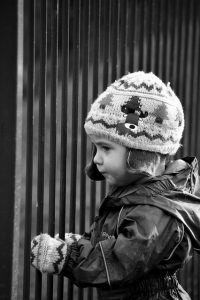 With the colder weather, comes the need for additional layers, and, in our house, additional stress from sensory sensitivities. All of my children have varying degrees of tactile sensory issues that are exacerbated with additional clothing. They all seem to warm up quickly and grow uncomfortable in long sleeves. In this article, I’ll share some of the approaches that have succeeded and failed as I’ve tried to protect my children from the elements over the last several years.
With the colder weather, comes the need for additional layers, and, in our house, additional stress from sensory sensitivities. All of my children have varying degrees of tactile sensory issues that are exacerbated with additional clothing. They all seem to warm up quickly and grow uncomfortable in long sleeves. In this article, I’ll share some of the approaches that have succeeded and failed as I’ve tried to protect my children from the elements over the last several years.
Forced Immersion
I have mixed feelings about my son’s former ABA program, but I am clear about my opposition to their approach in this area. When he was in kindergarten, he had a severe aversion to wearing gloves. If he wanted to play outside, we simply let him go without them. If he got too cold, he would reluctantly comply, but he never proactively put them on. But his school had a policy requiring students to wear a hat and gloves to school in weather under 40 degrees. When I explained this complication to his ABA program manager, she created a plan to address it. Her idea was to force him to wear gloves for a short amount of time and then gradually increase it. Of course, my son wasn’t interested in these trials and the therapist’s recommendation was to restrain him and force the gloves on him when he refused to comply.
This practice confused and overwhelmed him. I hated the idea of torturing him in this way. Instead, I chose to take advantage of my son’s strict adherence to systems and rules. He responds well to predictable systems that he understands. So I showed him the letter from his principal that was sent home explaining the expectation of students to wear hat and gloves to school. When he woke up the next day (and every winter day following), he asked what the temperature was, but allowed me to put his gloves on without incident.
Offering Choices
Whenever possible, my husband and I try to offer our children options–let them decide things so they can achieve a sense of self-control and value. So if the weather isn’t going to cause permanent physical harm, I usually don’t force them to wear gloves or hats if they don’t want to. I give them a choice. I’ve found they are more likely to choose these extras after they’ve experienced the cold and understand why these articles are useful. This is true for both my autistic son and non-autistic children.
This strategy might not work for everyone in all situations or at all ages where the sensitivity is too distracting/assaulting; but explaining reasons and allowing children to experience natural consequences might be a good place to start.
Making It Fun
Sometimes children respond better to imaginative play and novelty rather than perceived meaningless parental mandates. You could compare the idea of winter clothing to wearing a costume. There are plenty of different matching hat/glove combinations that you could find to suit your child’s interests. Winter garb might also be considered armor for an imaginative battle with enemies of the cold weather.
Alternatives/Things to Try
If you have a child with clothing sensitivities, then you probably have learned to get creative with the winter attire. There are lots of non-traditional approaches that may help in this area. For example:
- Consider using mittens instead of gloves that isolate each of the fingers and may create additional discomfort. Thick socks can also be worn on the hands for this purpose.
- Longer sweatshirts that can hid hands underneath coat sleeves and provide warmth in most situations.
- Offer breaks from the undesired clothing when playing outside. Allow them 10 minutes on followed by 10 minutes off or whatever alternative might be appropriate for the weather. This will allow them to experience both conditions, safely continue playing, and hopefully learn what feels most safe and comfortable for the future.
This can be a stressful issue for a lot of families, but not matter how you approach it, I think its important to remember the central purpose of teaching appropriate clothing use: safety. Focus your efforts on teaching your children to independently make safe clothing choices, and choices that make them the most comfortable so they can function optimally. What is comfortable for you might not necessarily be optimal for them.

Bespoke Tailors USA
Miles
nancy leduc
Jenna